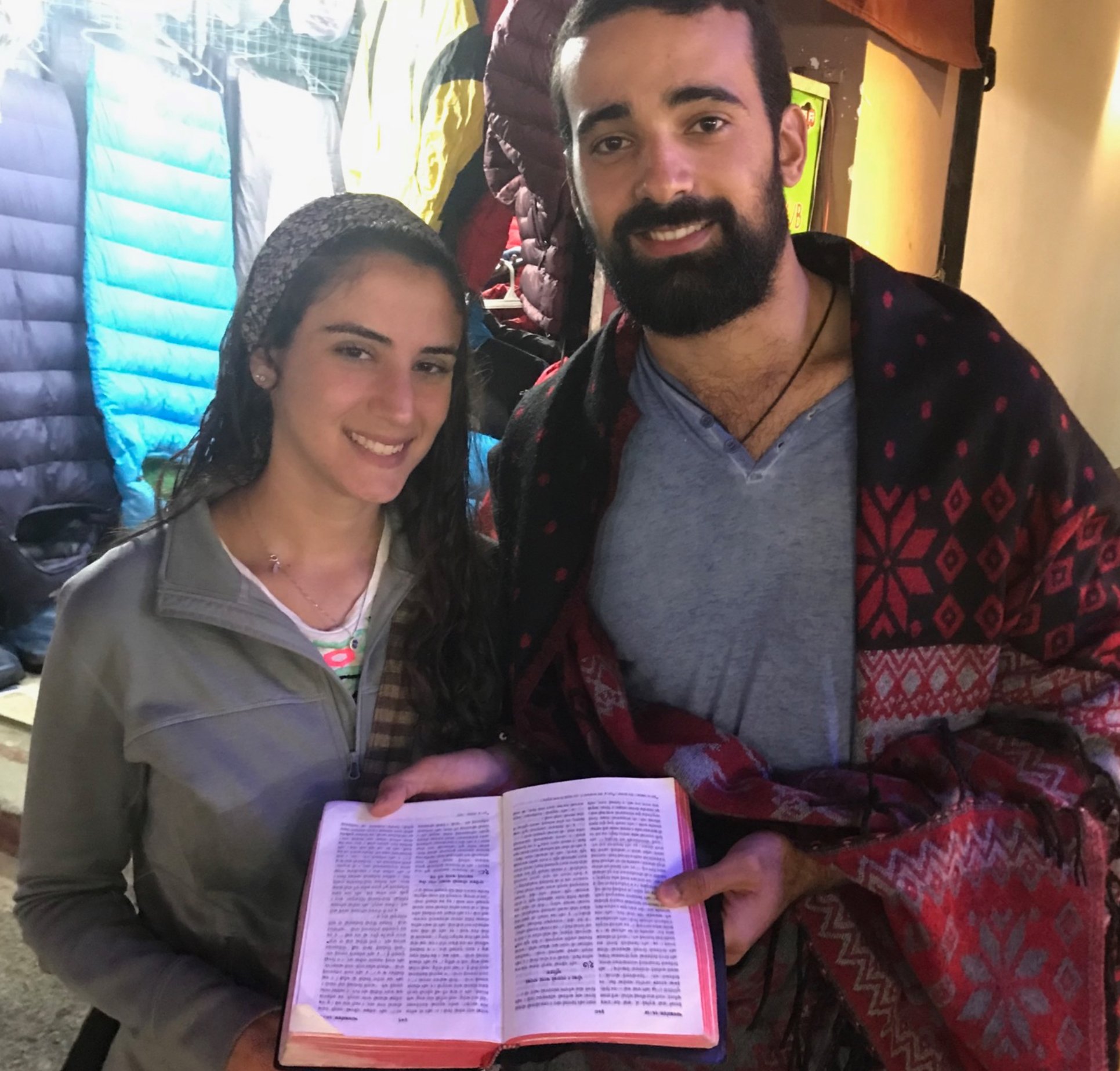the israeli backpacker phenomenon
Two Israeli backpackers react with amazement on the streets of Kathmandu when shown a copy of the Bible translated into the Nepali language.
In the 1970’s came the drifter-tourists. Having completed very tense Israel Defense Forces (IDF) conscriptions in very tense times, these individual nonconformists began reacting to the predictable status quo of Jewish life in a land surrounded by enemies who wanted to push them into the sea. They took a break and went trekking! Most of these early drifter-tourists came from the socio-economic center of Israeli life and were forced to travel on a shoestring budget. They went to places where it was cheap to subsist and where Jewish people could normally travel uninhibited and without fear of antisemitic retaliation. These pioneers unwittingly blazed trails in South Asia and South America, established popular itineraries, and forged bucket lists that would become popular, a predictable status quo in and of itself, for the Israeli trekkers who would come later.
From 1967-1982, the Sinai Peninsula was under Israeli control, fairly conquered in a war started by the Arab nations and in which Israel successfully defended itself. I’ve heard tales about the Sinai in those days: gorgeous beaches, amazing hikes, and popular treks. It was a veritable escape for many Israeli youths, and it was safe. Unfortunately, the Sinai was returned to Egypt in 1982 in exchange for a fragile peace (big mistake, in my humble opinion); and today, it has become a hellhole. The place is overrun by terrorists, it’s been trashed in characteristic Muslim fashion; and tourists cannot travel from Israel’s modern-day border near Eilat to visit the pyramids near Cairo without a heavily-armed Egyptian military escort.
After Israel withdrew from the Sinai, Israeli trekking in the 1980’s escalated, and youths freshly out of compulsory IDF service began choosing distant destinations, particularly the trails and itineraries blazed in South Asia and South America by the early drifters. After the Oslo Accords were signed in 1993, Israel’s economy took off, the cost of airfare dropped, and a Post-IDF great journey all but institutionalized as a rite of passage. Drifter paths in South Asia and South America became enshrined as Hummus Trails where those who come from Israel’s middle and upper-middle class want to follow in the footsteps of those went before, even mimicking the shoestring budgets of the early drifters when lack of funds is not an issue. A 2005 Outside Magazine article entitled “The Book” described the phenomenon thus:
For Israelis, travel is therapy. “There is a sense of a mental prison living here, surrounded by enemies,” explains Yair Qedar, editor of the Tel Aviv–based travel magazine Masa Acher. Every moment is pregnant with menace. A trip to the pizzeria can end in the flash of a bomb. And there is the claustrophobia of tight-knit families in a miniature country hemmed in by ancient social traditions. “Suffocation is a constant feeling," Qedar says. “When the sky opens, you get out.”
And that is precisely what many Israeli youth, fresh out of conscripted military service, have done. About five years ago, it was estimated that somewhere between 30-40,000 young adults left Israel annually for an average time period of six months to travel specific regions of the world, a rite of passage that one must needs experience before entering university studies or the Israeli workforce. About 2/3 of these would travel the Hummus Trail in South Asia (India, Nepal, and Thailand), and approximately 1/3 would opt for the Hummus Trail of South America (Argentina, Chile, Brazil, Bolivia, Peru, Ecuador, and Columbia). And, along these trails, there are predictable hubs that many transit through (e.g. Kathmandu, Leh, Manali, Goa, Bariloche, Huaraz, etc.).
The numbers have only grown in the last few years, and destinations in other places generally friendly to Jewish people (New Zealand, parts of Eastern Europe, Central America, and working mall kiosks in the United States and Canada) have likewise increased in popularity. Many of the Israeli trekkers we meet in places like Nepal, Ladakh, Peru, or America’s shopping mall kiosks are in the formative transition from adolescence into adulthood, and they are therefore seeking travel experiences to define themselves and help set a course for a future back home. As a result, there is an openness to the things of Messiah during this time in the spirit of Solomon’s admonition in Ecclesiastes 12:1:
Remember now thy Creator in the days of thy youth, while the evil days come not, northe years draw nigh, when thou shalt say, I have no pleasure in them.
For us Gentiles who have been changed by the power of Jesus the Jewish Messiah, we owe a great debt of gratitude to the Jewish people. Through them, we are given the WORD of God (Romans 3:1-2); the CHRIST of God (Romans 9:1-5); the APOSTLES (Acts 1:2-3); and the first CHRISTIANS, the first local NEW TESTAMENT CHURCHES, and the first MISSIONARIES (Acts 11:19-21). Moreover, we must needs remember that as SALVATION is to the Jew first, and also to the Gentile (Romans 1:16), so also is the JUDGMENT (Romans 2:8-9). Are not these things enough to motivate us to seek out opportunity to share the Gospel of the Jewish Messiah with the lost sheep of the house of Israel. Are not these things, along with the example of Paul, the Apostle to the GENTILES when he finally arrived in Rome (Acts 28:16-31), not enough to compel us to be friends of Israel and the Israeli backpacker?

